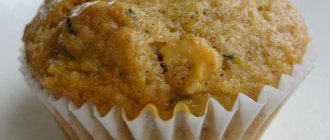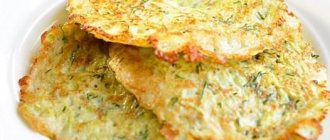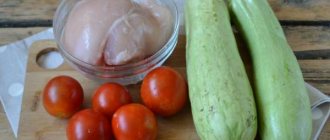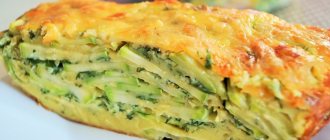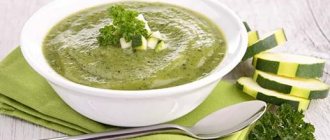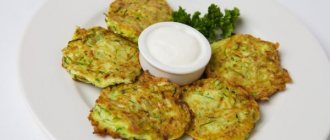Stewed zucchini: calorie content and nutritional value per 100 grams, benefits, use in weight loss
- 5 What vitamins do zucchini contain?
- 6 about the benefits of a popular vegetable
- The glycemic index is only 15, which means that the food does not raise blood sugar levels. Simply boiled zucchini in water without adding spices has a neutral taste that few people like. This dish has only 25 calories.
- The calorie content of squash caviar can vary, much depends on the method of its preparation. Calories are affected by the vegetable oil used for cooking. If vegetables were stewed during heat treatment, then the calorie content of caviar will be 70 kcal per 100 grams of product. If fried - 95 kcal per 100 grams of product.
- The calorie content of stewed zucchini is 80 kcal per 100 grams, but will depend on additional ingredients that can increase or decrease the number of calories. When adding flour and potatoes, the number of calories may increase.
- The calorie content of fried zucchini is approximately 88 kcal. For frying, as a rule, eggs, flour, vegetable oil and the vegetable itself are used. Such a dish cannot be called healthy, because after frying, the finished product is filled with carcinogenic substances that provoke the occurrence of cancer.
- The calorie content of zucchini baked in the oven without additives is 24 kcal. If you add other vegetables, for example, tomatoes and spices, the number of calories will increase to 50 kcal per 100 grams of product.
- Want to know how many calories are in steamed zucchini? It contains only 23 kcal.
It is very important for people who watch their figure to know how many calories they eat per day so that the process of burning fat begins.
To start it, you need to reduce the number of calories consumed per day by 500 kcal. To do this, you need to reconsider your diet and reduce your intake of fatty foods. The best helpers will be fruits and vegetables, which have all the vital vitamins and minerals, but at the same time satisfy hunger well. Today we will talk about the benefits and calorie content of zucchini in its raw form, as well as after heat treatment.
How many calories do zucchini contain?
Zucchini has long been considered a dietary product due to the fact that 100 grams of raw zucchini contains only 24 kcal. It can be eaten raw or stewed, boiled, baked, fried. Let's take a closer look at how the calorie content of a vegetable changes after heat treatment.
Beneficial features
The vegetable has a wonderful effect on the human body. Its positive influence extends as follows:
- Magnesium and potassium actively support the functioning of the cardiovascular system.
- Due to the iron content in the vegetable, the blood is saturated with oxygen.
- Vitamins help strengthen the immune system and increase resistance to viral diseases.
- Zucchini helps remove excess fluid from the body, which is useful for both those losing weight and those suffering from edema.
- Toxins are also removed. In case of poisoning and after drinking alcohol, you can eat dishes from this vegetable in order to help the body facilitate the process of removing harmful substances. Also has choleretic properties.
- Rejuvenation of body cells can occur due to the antioxidant substances contained in zucchini. Skin aging slows down and appearance improves significantly.
But you shouldn’t overuse dishes made from this product. If you eat something in large quantities constantly, you will develop disgust even without any contraindications.
And people suffering from gastric diseases such as gastritis or ulcers are not recommended to take it raw.
When purchasing zucchini products (for example, zucchini caviar), do not forget to check the expiration date - poisoning can occur from poor-quality food, which cannot be alleviated by dishes from the same vegetable.
Composition of the product
Nutritional value in 100 g of raw vegetable and percentage of daily value (in grams):
- Proteins – 0.6 (0.73%),
- Fat – 0.3 (0.46%),
- Carbohydrates – 4.6 (3.59%),
- Water – 93 (3.63%),
- Dietary fiber – 1 (5%),
Fried:
- Proteins – 1.1.
- Fat – 6.0.
- Carbohydrates – 6.7.
Energy value
All calories can be broken down into carbohydrates, fats and proteins as follows:
- Proteins provide approximately 2-3 kilocalories.
- Fats account for 3-4.
- Carbohydrates - 18 kcal.
In terms of ratio, the product consists of approximately 80% carbohydrates. Due to its low fat content, zucchini is recommended as a dietary product, both raw, boiled or stewed, for anyone losing weight. Zucchini dishes are a losing weight woman’s best friend.
How to eat to lose weight: advice from nutritionists
Zucchini, especially in the summer-autumn period, have an affordable price and are not picky about storage. Due to its composition, it has a positive effect on digestion.
Dietary fiber keeps you feeling full for a long time and does not cause allergies, which is why nutritionists recommend this food for many diets, especially for weight loss.
There is even a special menu where the main ingredient is stewed or boiled zucchini. Fried ones are not suitable for such purposes.
The basic rule of the diet is to eat zucchini in different forms every day for several days. Also included in the menu are lean meats, fish, fermented milk products, other vegetables, fruits, and herbs.
Oatmeal and buckwheat are allowed from cereals. When choosing a balanced diet, this regimen can be followed for a long time. You need to drink up to 2 liters of water per day, the last meal should be no later than three hours before bedtime. The best helper will be physical activity - for example, visiting the gym.
Stew with carrots and herbs
| Zucchini | 2 pcs. |
| Carrot | 1 PC. |
| Vegetable oil | 2 tbsp. l. |
| Parsley | 0.5 bunch |
| Dill | 0.5 bunch |
| Salt | 1-2 pinches |
| Ground pepper | 1-2 pinches |
- 100 grams of product contains 40 kcal;
- proteins 0.6 grams;
- fat 2.2 grams;
- carbohydrates 5.2 grams.
Grate the carrots on a coarse grater, cut the zucchini into cubes or cubes. Pour vegetable oil into a frying pan, add vegetables, simmer until soft under the lid. Then add salt, pepper, other spices as desired, chopped herbs, cover and simmer for another 5 minutes.
Pancakes with carrots
| Zucchini | 1-2 pcs |
| Carrot | 100 g |
| Parsley | 1 bunch |
| Flour | 100 g |
| Eggs | 2 pcs. |
| Sunflower oil | 1 tbsp. l. |
Grate the zucchini with a fine grater and squeeze out the liquid. Grate the carrots too, combine the vegetables, add eggs, chopped herbs, and flour.
Knead the batter and fry in hot vegetable oil on both sides until golden brown.
- 100 grams of product contains 84 kcal;
- proteins 3.2 g;
- fat 2.2 g;
- carbohydrates 13 g.
Squash Cavier
| Zucchini | 3 pcs. |
| Onion | 3 pcs. |
| Carrot | 200 g |
| Tomatoes | 2-3 pcs. |
| bell pepper | 1 PC. |
| Vegetable oil | 120 g |
| Salt | 20 g |
| Sugar | 80 g |
Chop all vegetables finely. Simmer the zucchini in a thick-bottomed pan. Onions, peppers, carrots should be fried in a frying pan with vegetable oil. After 2-3 minutes, add chopped tomatoes to the vegetables and simmer for 5 minutes.
Then send the frying to the zucchini mass, mix everything, add salt, pepper, sugar, simmer under the lid for 5 minutes. Use greens for garnish when serving.
- the calorie content of 100 grams of squash caviar is 83 kcal;
- fat 5.4 g;
- proteins 0.7 g;
- carbohydrates 8 g.
Source: https://miss-runet.ru/pohudenie/kalorijnost-kabachkov.html
Zucchini baked in the oven calories. Baked zucchini in the oven calorie content
Zucchini is the most popular vegetable in our country. It is easy to care for and grows well in Russian weather conditions. Oven-baked zucchini, zucchini caviar, numerous zucchini salads and even desserts - all this can be prepared from a tasty and healthy vegetable.
Composition and beneficial properties of zucchini
Zucchini belongs to the pumpkin family and is a type of common pumpkin. Zucchini can be stored for a long time under simple conditions, so we have the opportunity to enjoy delicious dishes made from it for a long time.
The calorie content of zucchini is pleasing - only 24 kcal per 100 g, which allows it to be used in dietary nutrition. Zucchini consists of 94.5% water, 0.6% protein, 5.2% carbohydrates, some of which are sugars, containing a little sucrose.
Zucchini is rich in the presence of many useful mineral salts - potassium, phosphorus, calcium, magnesium, sodium, iron, sulfur. Molybdenum, titanium, aluminum, lithium, and zinc are present in a small volume.
Zucchini contains many vitamins: C, provitamin A, B1, B2, nicotinic acid.
Zucchini is useful for those who are losing weight and those who watch their diet, for diabetics because it lowers blood sugar levels, for people suffering from diseases of the gastrointestinal tract, it is useful for baby food, and for mature people it is useful because it has a positive effect on blood renewal . Skin diseases, hypertension, kidney disease - zucchini will help cope with these problems. Learn more about the benefits of zucchini.
Oven-baked zucchini: nutritional value
As a rule, Russians do not consume fresh zucchini, although there are recipes for salads with the addition of fresh zucchini. When boiled, zucchini is useful, but there are few adherents of a healthy diet who eat boiled zucchini without oil and salt; it is tasteless.
On the contrary, many people like zucchini fried, but in this case it will be less healthy, and due to the addition of oil, the calorie content of such zucchini will increase significantly.
Is there really no way to cook zucchini deliciously, preserving its beneficial properties and not greatly increasing the calorie content of the product? There is such a way - zucchini baked in the oven. If you bake the zucchini in the oven in foil, it will retain maximum of its beneficial substances and properties.
Then there is no need to add oil, which will make the dish not only tasty and healthy, but also dietary. The calorie content of zucchini baked in the oven is about 33 kcal per 100 grams. At the same time, all of the above beneficial properties of zucchini are preserved.
Do not add salt to the zucchini before baking, otherwise you will not get a crispy crust. Salt before serving the dish. It's best not to peel before baking to prevent the zucchini from becoming limp. Therefore, it is better to take young zucchini, they have a thin peel that is good for food. Before baking in the oven, dry the zucchini well, otherwise drops of moisture remaining on the zucchini will damage the shell of the vegetable.
Time and temperature for baking zucchini in the oven with garlic
Zucchini baked with garlic and cheese is an original budget dish that is very simple and quick to prepare. It turns out tender, aromatic and low in calories. For cooking, choose small or medium-sized fruits, preferably young ones.
Note! If you only have mature vegetables in stock, you need to peel them and remove the seeds.
Ingredients:
- medium-sized zucchini - 6 pcs.;
- hard cheese (45% fat) - 250 g;
- garlic cloves - 3 pcs.;
- salt - to taste;
- sunflower oil - 2 tbsp.
Cooking method:
- Wash the zucchini, cut each one lengthwise into 2 equal parts.
- The cheese is grated and mixed with chopped garlic, salt and pepper.
- The prepared fruit halves are greased with vegetable oil and placed on a baking sheet covered with parchment. Sprinkle garlic-cheese mixture on top.
- Vegetables are placed in the oven for 20-25 minutes at 180°C.
- Zucchini is baked until golden brown. The finished dish is served with sour cream sauce and herbs.
Vitamins and benefits
- Zucchini is popular due to its composition. It contains vitamins C, B2, B6, B9, K, A. Among the minerals, its components are manganese, magnesium, potassium, copper, calcium, phosphorus. The peel is filled with fiber, folic acid, and antioxidants.
- It has a positive effect on the formation of bones and muscles, thanks to calcium, which is well absorbed along with magnesium.
- Positively affects heart function and reduces blood pressure. The risk of strokes is reduced.
- Vitamin C has a beneficial effect on the immune system.
- Thanks to folic acid, vegetables have a beneficial effect on fetal development and reduce the risk of Alzheimer's disease.
- Potassium stimulates brain function and improves cell activity.
- Magnesium helps to avoid or quickly overcome depression, stress, and fills the body with strength.
- Vegetables improve vision, which deteriorates with age.
- If you cover your eyes with pieces of fresh zucchini, you can relieve redness and fatigue.
- High fiber levels and low glycemic index help you lose weight quickly.
- Vegetables promote collagen production, which improves skin condition.
Ingredients:
- Zucchini – 2 pieces
- Cheese - 50 grams (Parmesan)
- Salt - 1 pinch
- Spices - 1 teaspoon (ground garlic, basil, thyme)
- Olive oil - 2-3 teaspoons
Number of servings: 3-4
Fried zucchini recipe and nutritional value
Ingredients:
- Zucchini – 500 grams;
- Egg – 2 pieces;
- Flour – 1 tablespoon;
- Vegetable oil – 100 g
Cooking method:
Cut the zucchini into circles, mix the flour and eggs thoroughly.
Dip each circle in a mixture of eggs and flour, fry in a frying pan with hot vegetable oil.
You can also spread each fried zucchini circle with mayonnaise and garlic; the calorie content of such a dish will be 94 kcal per 100 grams of product.
Calorie content of products and finished dishes:
Product MeasureWeight, g Fats, g Proteins, g Carbohydrates, g Calories, kcalorie Zucchini Egg Flour Vegetable oil Total 100 g
| 500 g | 500 | 1,5 | 3 | 23 | 120 |
| 2 pieces | 94 | 10,24 | 11,94 | 0,66 | 147,58 |
| 1 spoon | 25 | 0,3 | 2,3 | 18,72 | 85,5 |
| 100 | 99,9 | 899 | |||
| 719100 | 111,9415,56 | 17,242,39 | 42,385,89 | 1252,08174,14 |
Culinary processing and calorie content of zucchini
Of course, the calorie content of raw zucchini depends largely on the variety. Few people dare to eat this vegetable raw. Although there are salad recipes in which zucchini is not cooked. But this is still exotic for Russian cuisine. In our country, zucchini is traditionally served fried, stewed or in the form of zucchini caviar.
If you simply boil the zucchini or cook it in a double boiler without adding other products, you will get a healthy and record-breaking low-calorie dish. The calorie content of boiled zucchini is 22-25 kilocalories per 100 grams.
By grinding such a zucchini in a blender, you will get a vegetable mass that has rightfully won first place among complementary foods for infants.
Naturally, since this product is safe and necessary for children from six months old, then it will be quite useful for adults. But there are few of us who agree to simply eat boiled zucchini. For many, this dish is not very attractive in taste.
But we all love and enjoy eating squash caviar. The calorie content of squash caviar depends on the method of culinary processing of vegetable raw materials. If the squash is boiled, the color of the final product is quite light, and the calorie content of squash caviar in this case is only 70 kilocalories per 100 grams.
And if the vegetables are fried, the color of the caviar will be darker and the energy value will be higher. The calorie content of squash caviar in this situation is 90-95 kilocalories per 100 grams. The chemical composition of the product contains water (83 grams), carbohydrates (8 grams), dietary fiber (2 grams), fats (5 grams), proteins (2 grams).
The calorie content of squash caviar is much higher than just zucchini, since quite a lot of fat is added to it during production. It is the oil that gives the dish its calorie content. Each gram of fat contains 9 kilocalories, which is significantly higher than in proteins and carbohydrates.
Now different companies use different recipes for squash caviar. Very often sugar is added to it. This additive reduces the dietary properties of the dish. It is best to prepare caviar from zucchini yourself at home using proven recipes.
The calorie content of stewed zucchini is also largely related to how exactly they were prepared. To reduce the energy value of the dish, avoid adding oil when stewing, do not use flour or potatoes. If your dish consists only of stewed vegetables, then its calorie content will remain low.
On average, the calorie content of stewed zucchini is about 80 kilocalories per 100 grams. A dish prepared according to the following recipe will have this energy value.
Take 300 grams of zucchini, 30 grams of olive oil, 200 grams of tomatoes, 1 egg, 30 grams of onion. Cut the zucchini into thin slices and fry in olive oil. Add peeled tomatoes.
Simmer for 10 minutes. Beat in the egg and serve hot.
Product nutrients (details)
Chemical composition and nutritional value of fried or baked zucchini Calories Vitamins Amino acids Minerals
Squirrels
Source: https://GolovaNeBoli.ru/trenirovki/kalorijnost-zapechennogo-kabachka.html
Application
Zucchini is 95% water. To get rid of excess moisture, before cooking it is recommended to sprinkle the cut zucchini with salt and leave for half an hour. Then drain the released liquid. Since the peel contains a lot of useful substances, there is no need to peel it. The younger the vegetable, the more tender its pulp and peel. Zucchini flowers are also used in Italian and French cuisine.
Zucchini is used in many Mediterranean dishes. Stuffed zucchini with various fillings, stewed and baked are especially popular. Zucchini goes well with fish and white meat.
Market Analytics
- COVID-19 is changing the rules of the game in the cosmetics market
- Beauty of the future: cosmetic innovations 2020
- New ingredients are the driving force of the cosmetics industry
Convenient search for beauty salons on our website
Beauty salons in Moscow Beauty salons in St. Petersburg Beauty salons in Ekaterinburg Beauty salons in Novosibirsk
Latest blog posts on our website
- Naturecream / Geranium (Pelargonium) oil for skin health and beauty
- Prostye-sovety / Save on a beauty salon: procedures that can be done at home
- Naturecream / Growth Factor - brings back youth?
- Oksana-Lezina / 3 effective abdominal exercises from a fitness instructor for beginners
- Prostye-sovety / Making perfect curls at home
- Prostye-sovety / Which hair removal method to choose
- Naturecream / Wrinkles Puppets
- Naturecream / PEPHA-TIGHT - instant skin lifting
- Naturecream / Blue light - a danger to the skin
- Naturecream / Cocoa Butter – A treat for the skin
Latest forum topics on our website
- Mrs._Smith / Badly sunburned! What to do?((
- Ice / Is it necessary to combine fitness classes with a diet?
- Antonova / What can be used for hair loss?
- Radio operatorKat / Who was on a protein diet?
- Suzanna / Mesotherapy on the face
Other articles in this section
| Dried white cabbage White cabbage has been grown for more than 2000 years. The ancient Greeks valued cabbage for its medicinal properties and nutritional value. There are more than one hundred varieties of cabbage. Dried cabbage retains all its nutritional properties and taste. |
| Parsnip Parsnip is a root vegetable that has been used in cooking and medicine in Eurasia since ancient times. It is a close relative of carrots and parsley, and was often confused with carrots in ancient records. This hardy annual or biennial plant has many uses. Thus, it was used to sweeten dishes before cane sugar was brought to Europe. In many European cuisines, parsnips are still a daily vegetable dish, such as in Scotland and the UK. |
| Roasted Cauliflower Like other types of cabbage, cauliflower is descended from wild kale. Since ancient times, it has been grown in the Mediterranean region. The head of cauliflower is formed from small, densely grouped white buds. There are also varieties in green, orange and purple. Cauliflower loves moderate climates and fertile, moisture-rich soil. |
| Black beans Just like white and red beans, black beans are a type of common bean. It has been grown in South America since ancient times. After Spanish colonialists brought beans to Europe in the Middle Ages, this vegetable crop spread and became popular throughout the world. |
| Elecampane According to ancient Greek legend, elecampane owes its Latin name (Inula Helenium) to Helen of Troy. Where her tears fell, this medicinal plant grew. The ancient Greeks and Romans considered elecampane a panacea for many diseases. The plant reaches a height of more than a meter, the flowers resemble sunflowers, but are smaller in size. Grows in Europe, Asia, North America. |
| Red beans Red beans belong to the type Common beans. Red bean seeds are deep dark red in color. This vegetable crop has been cultivated in South America for thousands of years. In the 15th century Spanish colonists brought beans to the European continent, where they became widespread. Due to their high nutritional value, beans are used throughout the world as a substitute for animal protein. |
| Garlic (pickled arrows) The benefits of garlic are mentioned even in the Bible and the Koran. Records of garlic are found on Sumerian cuneiform tablets dating back to 2300 BC. e. In ancient Egypt, garlic was revered as a sacred plant and was used for embalming. The arrows of garlic are similar to the arrows of green onions. At the end of the arrow, a flower blooms, and then a small box with seeds ripens. |
| Purslane Purslane is a leafy vegetable plant 12-15 cm high. Its homeland is the Indian subcontinent, but currently purslane is common in many countries in Asia and Europe. The succulent stems, leaves and buds are eaten. Purslane leaves and stems have a slightly salty and sour taste. Purslane has also been used in traditional Chinese medicine for a long time. |
| Roasted zucchini Zucchini belongs to the pumpkin family. Resembling the shape of a cucumber, mature fruits can reach a length of 50-70 cm. Unlike zucchini, zucchini is covered with a light yellow peel. Its homeland is Latin America. It was brought to Europe by conquistadors in the Middle Ages. The vegetable is rich in nutrients and is very popular in Russian cuisine. |
| Leeks Leeks have been known for their medicinal properties for centuries, although nowadays they are used mainly in cooking. This is a herbaceous plant of the onion family. Leeks have a pungent taste, although less pronounced than that of onions. The light green stems and white onion are eaten. Dark green leaves are more fibrous but contain more vitamins and can be used to make juice. |
How many calories are in zucchini, BZHU and calorie content per 100 grams
Zucchini is a common vegetable in Russia, so its use during weight loss takes on leadership notes.
The calorie content of zucchini per 100 grams allows you to consume it in unlimited quantities, but only fresh, boiled or baked. It is allowed to add meat or low-fat cheese.
Fried foods are also good for the body, but their calorie content is higher, so they are allowed to be introduced into the diet in small quantities.
Dishes made from zucchini can be different - they are stewed, fried in oil or without oil in a dry frying pan, cooked in the oven, on the grill, on the fire.
At the same time, the calorie content of the dishes changes dramatically, which should be taken into account if you need to lose weight or maintain a slim figure if you tend to be overweight.
Next, the cooking features and principles of increasing nutritional value will be discussed in detail.
About calories and nutrition
Zucchini is a member of the Cucurbitaceae family and is a white, yellow or dark green vegetable with an oblong shape. It is recommended for consumption in an unripe form, when there are no formed seeds inside and no hard fibers have formed around the core.
The BZHU of zucchini is presented in the table along with the calorie content per 100 g.
| Calorie content per 100 g | Carbohydrates per 100 g | Proteins per 100 g | Fats per 100 g |
| 23 kcal raw | 5.2 g | 600 mg | 300 mg |
The nutritional value of a zucchini dish can be increased up to 200 kcal, which depends on the method of preparation and heat treatment.
About the chemical composition
To evaluate the benefits of zucchini dishes, it is necessary to consider not only the calorie content, but also the chemical composition.
Zucchini contains the following beneficial microelements and substances:
- contains more than 93% water, which provides reduced calorie content,
- there is a lot of fiber here, which is why cooked zucchini in the oven or boiled promotes digestion and cleanses the body of waste and toxins - in the absence of mayonnaise or cheese in the dish,
- mineral salts, organic acids – saturate the body’s cells, which has a positive effect on the condition of the skin, nails and hair, as well as on the functioning of the cardiovascular system,
- vitamins E, PP, A, H, B1, B2, B5 and B9 – help restore cells and normalize the nervous system,
- contains sodium, calcium, iron, magnesium and phosphorus - these chemicals are involved in the formation of bone tissue,
- It contains a lot of ascorbic acid, so in summer and autumn it is recommended to consume this product in large quantities - this way colds are prevented.
If you need to maintain weight and take into account the calorie content of dishes, you should know that the nutritional value of oven-baked zucchini with the addition of sour cream will be only 80 kcal, while the use of mayonnaise increases the indicators to 150 kcal per 100 g of the finished product.
More details about the composition can be found in the table.
| Vitamins | Microelements | Macronutrients | The nutritional value |
| Vitamin C 15 mg | Iron 0.4 mg | Potassium 238 mg | Proteins 0.6 g |
| Vitamin H 0.4 mg | Calcium 15 mg | Carbohydrates 4.6 g | |
| Vitamin A 5 mcg | Phosphorus 12 mg | Fat 0.3 g | |
| Vitamin PP 0.6 mg | Sodium 2 mg | Water 93 g | |
| Vitamin B1 0.03 mg | Magnesium 9 mg | Fatty acids Saturated 0.1 g | |
| Vitamin B2 0.03 mg | Fatty acids Unsaturated 0.1 g | ||
| Vitamin B5 0.1 mg | Dietary fiber 1 g | ||
| Vitamin B6 0.1 mg | Organic Acids 0.1 g | ||
| Vitamin B9 14 mcg | Ash 0.4 g | ||
| Vitamin E 0.1 mg | |||
| Beta-carotene 0.03 mg |
Benefits and harms
Despite the rich chemical composition, the presented vegetable has advantages and disadvantages. They must be taken into account when regularly eating zucchini dishes, as well as if you want to lose weight.
The positive aspects include the following factors:
- low calorie content,
- the presence of fiber normalizes stool and intestinal function in general without causing diarrhea,
- lowering cholesterol levels,
- elimination of edema,
- improving the functioning of the genitourinary system,
- activation of hematopoiesis with improvement of blood quality,
- a ratio of sodium and potassium of 1:150 indicates normalization of water balance, which makes it impossible to provoke deterioration due to dehydration of the body,
- zucchini helps prevent atherosclerosis,
- possibility of treating dermatological diseases.
Experts recommend consuming the vegetable if you have diseases such as diabetes, hypertension, colitis, cholecystitis and even hepatitis. In this case, it is necessary to strictly evaluate the benefits and harms.
Despite the enormous benefits of zucchini dishes, it is necessary to highlight the harm of the vegetable, which consists of the following factors:
- Patients with stomach ulcers or gastritis should include zucchini in limited quantities in their diet,
- You should not eat vegetables if your kidneys are not functioning properly, which is explained by the high potassium content in the product,
- the high fiber content also negatively affects the functioning of the digestive tract - fiber fibers come out of the intestines in a lump, which often provokes pain in the organ.
Consumption of zucchini dishes should be moderate. It is forbidden to lose weight only on zucchini, since this will only serve as the beginning of the development of diseases of the digestive tract.
A little more about the calorie content of dishes
Zucchini provides an opportunity to diversify your menu due to the numerous ways to prepare this vegetable.
But we should not forget about calorie content, which is presented as follows:
- the calorie content of a stew with the addition of a small amount of vegetable oil does not exceed 40-50 kcal per 100 g of product,
- boiled vegetable does not exceed 30 kcal in calories per 100 g of product,
- boiled zucchini puree with butter increases calorie content to 100 kcal,
- if you bake the rings with mayonnaise and cheese or fry the rings in batter, the nutritional value will increase to 150-200 kcal per 100 g of the finished product,
- baked zucchini with cheese without adding butter or mayonnaise is about 100 kcal,
- zucchini pancakes, fried without vegetable oil, increase nutritional value to 60 kcal,
- fried vegetable in flour and sunflower oil - this is already about 150 kcal,
- “fried” zucchini with garlic or with an egg without oil increases the calorie content to 60 kcal.
The most delicious vegetables are prepared on the grill or over charcoal - their energy value does not exceed 50 kcal per 100 g, and their taste is incomparable.
About the benefits of vegetables for women
Zucchini dishes are beneficial for women, which is determined as follows:
- If you arrange fasting days every week, eating low-calorie zucchini dishes, you can lose up to 4 kg in a month without difficulty and exercise.
- You can go on a strict zucchini diet, eating the vegetable boiled or baked without sauces or oil, for 5 days. During this time, the body will be completely cleansed of waste and toxins, which will have a positive effect on weight loss.
- Zucchini dishes are recommended to be consumed during pregnancy - they remove fluid from the body and normalize intestinal function. This is an excellent prevention of swelling and constipation.
- Zucchini can be consumed while breastfeeding – they do not change the taste of milk and have a positive effect on the baby’s digestion.
This is important: Women should take into account the specifics of use during pregnancy and after. A young mother should be careful when introducing zucchini into her diet during breastfeeding if there was no vegetable in her diet during pregnancy.
Benefits in cosmetology
This vegetable is actively used in the production of cosmetic products for industrial purposes, as well as at home. Zucchini juice helps even out your complexion, making it look natural and fresh. It is enough to squeeze the juice out of the vegetable and dip gauze in it for subsequent treatment of the facial skin.
It is better to simply put the gauze on your face for 15-20 minutes. Using the vegetable, you can remove rough skin from your feet - grate it and apply it to problem areas for half an hour, remove the soft skin with a pumice stone.
It is recommended to use a zucchini mask to strengthen the hair follicles - mix grated zucchini and onion in equal quantities, apply to the roots and leave for half an hour, then rinse with warm water and shampoo.
Data on the composition, how many calories are in zucchini and the features of its use, both in food and in cosmetology, are presented in detail. The information will help not only in losing weight, but also in eliminating numerous problems in the appearance of men and women.
Source: https://alkopolitika.ru/dietolog/diety/kalorijnost-kabachka
Useful properties of zucchini
Thanks to their beneficial properties, zucchini is simply an indispensable product for the treatment, prevention and healing of the human body. Zucchini improves the secretory and motor functions of the intestines and stomach, and activates digestion processes.
Due to the high content of ascorbic acid, zucchini has general strengthening properties, and the pectin substances included in its composition contribute to the easy digestibility of the plant’s fruits. In addition, zucchini fruits have a diuretic effect, remove excess water, sodium salts, heavy metals and toxins from the body, so zucchini caviar is very useful for gout, urolithiasis, nephritis, chronic pyelonephritis and metabolic disorders.
It is useful to eat zucchini dishes for atherosclerosis, hepatitis, hypertension, cholelithiasis, and cholecystitis.
Since zucchini is low in fiber, it is an excellent food for patients who have recently had intestinal or stomach surgery . It will also be useful to follow a zucchini diet for people recovering from poisoning. And thanks to its low calorie content, zucchini will be very useful for people seeking to lose weight. There are even interesting zucchini diets created specifically for obese people.
Due to its beneficial properties, regular consumption of zucchini improves the condition of the skin, nails and hair, as well as teeth and vision.
Zucchini is useful for cardiovascular diseases, duodenal ulcers, and anemia. People whose diet includes zucchini remain healthy, easy-going and active until old age. Zucchini is good for everyone: children, adults, the elderly, nursing mothers.
Benefits, harms, calorie content of zucchini per 100 grams
The calorie content of fresh zucchini per 100 grams is 24 kcal. 100 g of vegetable contains:
- 0.6 g protein;
- 0.3 g fat;
- 4.6 g carbohydrates.
The product is saturated with vitamins A, B1, B2, B5, B6, B9, C, E, H, PP, minerals potassium, calcium, magnesium, phosphorus, iron.
Calorie content of fried zucchini per 100 grams
The calorie content of fried zucchini per 100 grams is 88.2 kcal. In 100 g of dish:
- 1.12 g protein;
- 6.1 g fat;
- 6.6 g carbohydrates.
Read: Calorie content of Snickers per 100 grams
As we can see, fried zucchini has almost 4 times more calories than a fresh product. Despite heat treatment, they retain many useful substances, including vitamins B, PP, E, minerals magnesium, potassium, calcium, iron, phosphorus.
Calorie content of zucchini fried in flour per 100 grams
The calorie content of zucchini fried in flour per 100 grams is quite high and amounts to 198 kcal. In a 100-gram serving of this dish:
- 2.7 g protein;
- 17.8 g fat;
- 6.9 g carbohydrates.
To prepare fried zucchini in flour you need:
- mix 2 tablespoons of wheat flour and 3 chicken eggs in a bowl;
- cut the zucchini into circles, mix them with 5 g of salt;
- roll zucchini circles in flour with eggs;
- fry the deboned zucchini on 2 sides in vegetable oil.
Calorie content of oven-baked zucchini per 100 grams
The calorie content of baked zucchini per 100 grams is approximately 32 kcal. The low calorie content of the dish is due to the fact that a small amount of vegetable oil is required to prepare the baked vegetable.
Nutrition experts advise making a choice in favor of oven-cooked dishes. Fried zucchini is full of unhealthy fats, high in calories, and increases cholesterol levels.
Calorie content of stewed zucchini per 100 grams
Calorie content of stewed zucchini per 100 grams is 70 kcal. In 100 g of dish:
- 0.8 g protein;
- 5.4 g fat;
- 4.7 g carbohydrates.
Read: Calorie content of potato cake per 100 grams
Stewed zucchini recipe:
- cut into cubes and lightly fry 300 g of zucchini in 25 g of olive oil;
- mix zucchini with chopped 200 g tomatoes and 40 g chopped onions;
- add salt to taste;
- simmer the dish until cooked.
Calorie content of zucchini pancakes per 100 grams
The calorie content of zucchini pancakes per 100 grams is 140 kcal. In 100 g of zucchini pancakes:
- 3.6 g protein;
- 6.9 g fat;
- 15.6 g carbohydrates.
Recipe of dish:
- 0.5 kg of zucchini, finely grated;
- grated zucchini is mixed with 2 beaten chicken eggs;
- add 5 tablespoons of flour and salt to taste to the resulting mixture;
- Pancakes are fried in vegetable oil on each side.
Calorie content of zucchini with mayonnaise and garlic per 100 grams
The calorie content of zucchini with mayonnaise and garlic per 100 grams is quite large and amounts to 110 kcal. Per 100 gram serving:
- 1.2 g protein;
- 7.8 g fat;
- 8.6 g carbohydrates.
Read: Calorie content of dried coconut
Nutritionists do not advise getting carried away with such dishes. Contraindications to the use of such zucchini are chronic and aggravated diseases of the liver, gall bladder, stomach, intestines, excess weight, and high cholesterol.
The benefits of zucchini
The following beneficial properties of zucchini are known:
- the vegetable is rich in vitamins and minerals that normalize the functioning of the gastrointestinal tract and are necessary for the prevention of oncology;
- B vitamins from zucchini strengthen the nervous system;
- the product is enriched with beta carotene, a substance that has pronounced antioxidant properties and also inhibits oxidation processes in the body;
- phosphorus, calcium and magnesium from zucchini are good for healthy hair, nails and teeth;
- due to the high level of iron in the product, zucchini is indicated for the prevention of anemia;
- with regular consumption of vegetables, muscle pain is reduced and chronic fatigue is eliminated;
- Zucchini is enriched with dietary fiber, which reduces hunger and cleanses the body of toxins and waste.
Chemical composition
Zucchini has a similar energy value to zucchini, but the substances present in them are absorbed faster and better in the body. Fans of this vegetable may also be interested in what vitamins are contained in zucchini. Vegetables are high in sodium, potassium, magnesium, phosphorus and iron. They contain vitamins B, C, E, PP and pectin.
The green peel of the fruit contains a lot of fiber, which helps in the functioning of the digestive system. This property attracts many nutritionists along with its minimal calorie content and lack of fat.
Vitamin C in one vegetable is approximately 14% of the daily requirement. This is quite enough to actively use the small fruit to combat infectious and viral infections, especially in autumn and winter. Add boiled zucchini with 14 kcal to your diet, and you can strengthen your immune system, relieve symptoms of asthma and arthritis, and also prevent diabetes, heart disease and obesity.
Among the B vitamins, zucchini contains 4% thiamine, 10% riboflavin and 13% B6. Together, they help remove toxins from the body and protect it from cancer. The condition of the skin, hair and nails depend on them.
Low in calories, zucchini contains phytonutrients such as zeaxanthin and lutein. They help improve our vision and have a preventive effect on age-related ophthalmic changes.
